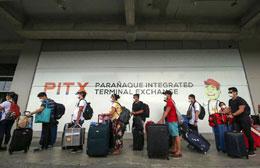Philippines to retrain 300,000 returning citizens

The Philippine government is trying to retrain hundreds of thousands of workers who are returning jobless from overseas as the coronavirus pandemic batters economies around the globe.
Already struggling with unemployment that spiked to record levels when the pandemic hit, the Southeast Asian nation is bracing for nearly 300,000 overseas Filipino workers – like caretakers, maids and seamen – to return home this year. The government is offering free programmes to reskill these workers for jobs such as call centre agents, teachers and contact tracers.
More than 5,000 returnees have already applied for the training, with health care, technology and tourism courses the top choices.
Among the returning workers is Marlon Gabitano, 51, a history teacher who was placed on unpaid leave from a school in Qatar. Back in the Philippines, where he has a wife and three sons to support in Pampanga province north of Manila, Gabitano has been attending government-backed online seminars to look for a temporary job or the means to set up a business.
“I’m looking for anything that can help tide us over, because life here in the Philippines is hard,” he said.
For decades, waves of college-educated Filipinos have left the country in search of better-paying work abroad. The money sent home by this diaspora of about 10 million people has helped fuel what until this year was one of the world’s fastest-growing economies – headed this year for a sharp contraction.
“Returning workers will have to compete with local jobseekers, but many sectors want to prioritise them,” Labour Assistant Secretary Dominique Tutay said in an interview. “It’s perhaps because of the difficult experience of leaving the country, then having to return after losing their jobs.”
Retraining these workers will likely be a “bumpy process”, said Jessie Lu, an economist at Continuum Economics in Singapore. So far, government support for displaced workers is “insufficient to offset the loss of income”, she said.
Some of them can be tapped as teachers, while seafarers can be hired for construction work, Tutay said. Returning migrants will be prioritised in hiring 50,000 contract tracers to help control Covid-19 infections, Interior Secretary Eduardo Año said at a briefing last week.
Business-process outsourcing, one of the few parts of the Philippine economy to escape the downturn, could be promising as a landing pad, with call centres willing to absorb returning workers with no background in the field, the Labour Department’s Tutay said. Jobs in telehealth – where agents answer customers’ health-related queries – are particularly in demand, she said. Still, the reskilling effort may be only a short-term fix.
“At least it’s helping them stay productive,” said Nicholas Mapa, senior economist at ING Groep NV in Manila.
But many are likely to head back overseas when better-paying work becomes available again.
While helping repatriated workers find jobs at home, officials aren’t abandoning the decades-long labour export policy. The government is seeking alternative labour markets for Filipino workers, including China and eastern Europe, Labour Secretary Silvestre Bello said in a recent online forum.
Gabitano, for his part, hopes to be part of that exodus again – despite the hardship of being separated from his loved ones.
“I will leave the Philippines again the first chance I have,” he said. “It’s hard to see my family suffering here every day.”






